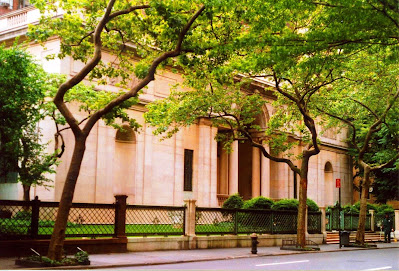 |
| Figure 1: Marlpit Hall, photo by Jolyon Pruszinski, taken with permission of the Monmouth County Historical Association. |
Marlpit Hall[1] is a well-preserved Middletown, New Jersey colonial-era residence which was owned by Edward Taylor and his descendants. It is now operated as a Museum by the Monmouth County Historical Association. Taylor and his family were Anglican and Episcopal enslavers who were part of the leadership of the Christ Churches of Middletown and Shrewsbury for decades. Interpretive materials at the exhibit state that
“from Edward Taylor’s purchase [of the property] in 1771 until at least 1832, the Taylor family of Marlpit Hall… had an unbroken chain of slave ownership. The men, women, and children who worked on the family’s farm fields, grist mill, and inside the house itself helped to maintain the Taylor family’s lifestyle.”
The exhibit at Marlpit Hall, which is entitled “Beneath the Floorboards: Whispers of the Enslaved at Marlpit Hall,” rightly focuses on the experiences of the people enslaved by the Taylors. Among these were at least ten for whom Marlpit itself was their primary residence, including York, Tom, Mary Ann, Elizabeth Van Cleaf, William Van Cleaf, Hannah Van Cleaf, Matilda Leonard, Clarisse Leonard, Ephraim Leonard, and George.
 |
| Figure 2: Quarters of the enslaved at Marlpit, photo by Jolyon Pruszinski, taken with permission of the Monmouth County Historical Association. |
 |
| Figure 3: The kitchen at Marlpit, photo by Jolyon Pruszinski, taken with permission of the Monmouth County Historical Association. |
One of the Anglican priests mentioned in the exhibits here at Marlpit Hall is Thomas Thompson, who served in New Jersey for about five years in a number of congregations in Monmouth County. While he did baptize some enslaved Black people (including at least one person he himself enslaved), he also was a staunch defender of slavery, writing a well-known treatise in defense of the trade. He wrote this treatise on the heels of his service as the chaplain to the slave trading company based in Cape Coast Castle off the coast of West Africa, a post he took up immediately following his service in New Jersey.
Another Anglican mentioned in the exhibit is the influential Lewis Morris, who contributed to the founding of multiple churches in New Jersey and would later become governor. He owned the iron works at Tinton Falls, where he enslaved over sixty people. As the exhibit states, “The enslaved labor working at Tinton Manor provided the template for Monmouth County’s budding slave society.”
The exhibit also mentions Morris’ cousin and business partner (also named Lewis Morris) who had been killed in the 1690’s by two enslaved men (Jeremy and Agebee). They were avenging Morris’ un-punished abuse and murder of a Black woman he enslaved.[2] Christ Church, Middletown is built over the site where Jeremy and Agebee were executed.
It is perhaps unsurprising, in light of their treatment by Episcopal enslavers, that enslaved African-Americans often did not ultimately affiliate with the Episcopal church. Rape of enslaved women by White male heads of household (and their sons) was common, and it is not unlikely that Matilda Leonard’s designation as “mulatto” in exhibit documents evidences this reality. She went on to marry Rev. James Simmons of St. James African Methodist Episcopal (AME) Church in Matawan. (Note: the African Methodist Episcopal Church is not part of The Episcopal Church, and was formed in response to mistreatment of African-Americans by the Episcopal Church).
The Marpit Hall exhibit provides excellent information about the history of slavery in New Jersey, material evidence of the lived experience of slavery for those who were enslaved at Marlpit, and documentation of the lives of their Anglican and Episcopal enslavers.
As you take the tour, and as you look around the beautiful home, remember the words of U.S. Senator Theodore Frelinghuysen who, in 1824 said “survey... your comfortable habitations, your children rising around you to bless you. Who, under Providence, caused those hills to rejoice and those valleys to smile? ... Remember the toils and tears of black men”[3] and women.
[1] The address is: 137 Kings Hwy.; Middletown, NJ 07748; Museum is open Fri-Sun 1-4pm. Other times for groups by appointment. See also: https://visitnj.org/marlpit-hall; https://www.journeythroughjersey.com/sites/marlpit-hall/; https://www.app.com/story/news/history/2021/10/20/middletown-marlpit-hall-slavery-exhibit- shackles/8507793002/.
[2] See Weeks, Not for Filthy Lucre’s Sake, 113.
[3] As quoted in Gigantino, The Ragged Road to Abolition, 189.

